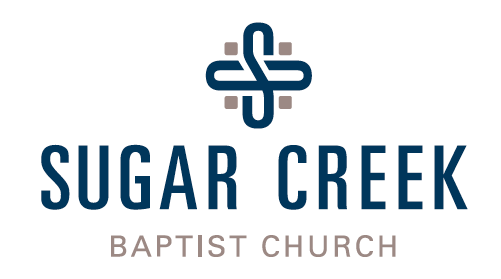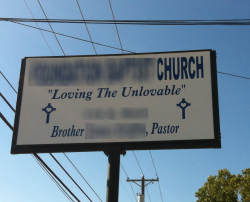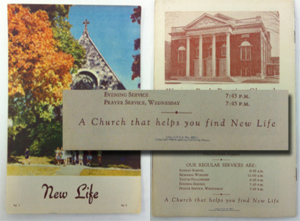
Your Brand is Probably Not What You Think It Is
Brand is the buzzword for businesses and organizations all over the world. It spurs countless meetings and brainstorms, millions of dollars in research and hundreds of pages in manuals. It has shifted messaging and advertising campaigns. It has prompted new logos, flashy design, catchy taglines. And, after all of that, people still don’t know how brands are made.
A reality check might help. Jeff Bezos to the rescue: “Your brand is what people say about you when you’re not in the room.”
Of course, you may have a clear idea of what you want people to think about your church or organization—you’ve got it all documented in your brand manual with definitions of brand values, essence, promise and guidelines. Great start. But, that’s not what makes a brand dream come true. Your vision may be well documented and poorly demonstrated.
Is the brand you’re promoting what your audience actually experiences? The answer is found in the space between what you profess and what you practice. (Age old “perception vs reality.”)
Ready for a reality check? Review your game films.
Think through all the places people interact with your church – map out an individual experience from the website to the event. Keep in mind, everything communicates – each email, Facebook post, online review (and response), announcement slide, service handout, interaction with staff or volunteer, trip to the bathroom, sign, check-in lines, payment process, traffic flow, etc. Make a list of all of these “touch points.” Then, one at a time, compare what you “say you are” to “how you behave” in each transition and each interaction.
A brand is a living entity – and it is enriched or undermined cumulatively over time, the product of a thousand small gestures.
– Michael Eisner, Former Walt Disney CEO
Did you catch that? The cumulative sum of every touch point defines your brand reality. (Shocking, I know. It’s not what we say, it’s what we do.)
So, it’s true what they say. You should sweat the small stuff. And, here are seven ways to get started.
1. Run empathy practice drills. When your communication engine feeds on calendar event promotions and transactional efficiency alone, the body doesn’t get what it needs to stay healthy. When the body is malnourished, it starts to feed on itself. A peak performing communication engine, on the other hand, grows healthy by feeding on empathy; planning logistics around the human factor in every step of every interaction.
- What is he leaving behind – an ailing parent, a stack of unpaid bills?
- What did she have to do in order to get here today – pack a diaper bag but still forgot diapers, argue with a spouse who is turning away from God?
- What is he facing when he leaves – an empty house, a demanding boss, a draining job?
- What stress is she carrying – fractured relationship with her kids, shared custody, abuse?
(Are you starting to see why redesigning a logo isn’t making the splash you think it is?)
2. People watch. Set up listening posts and take note of interactions, tendencies and requests. Are people taking bulletins and reading them? Do most people arrive late and are missing the announcements? What questions are people asking at guest services? Train your staff and core volunteers on the first line of defense to ask questions. Create a safe conversation where guests/attenders can be heard, and truth shared – no offenses taken. Stress the importance of wanting to know how you can get better.
3. Check data vitals. When is the last time you evaluated your website analytics (versus just tracking counts)? For example, look beyond how many people are coming to your site and check out:
- how they’re coming to you (direct URL, search or link from somewhere else)? That will give you insight around whether or not people are finding you via referral, your promotions or other.
- how they’re viewing your site (on mobile devices or desktop). This will give you insight around how they’re using your content; at home or on the go. Is your site mobile-friendly?
- how long are they staying? This will give you insight on how helpful and user-friendly your content is.
- what are they clicking on? This will give you insight on what content is most relevant for them.
- what are they searching for? This will give you insight on what might be missing, what might be buried in navigation, what jargon is misleading.
I’m sure you’re starting to get the idea by now. And, if you’re ready to dive into what to do with this new insight, I’ve dug up two articles to get you out of the gate.
4. Start social listening. You can dive pretty deep into this one – but don’t get lost in the data. Start with the basics and then ramp up. At the very least, set up a Google Alert. Be alerted to any mention of your church name and top leaders but also Christian, church and perhaps your particular denomination. Look into top trends on Facebook, Twitter and Instagram. What are people looking up? What are people talking about? How are they talking about your church or sermon topics? If there isn’t any online chatter about you… what might that mean?
There are countless ways to approach this, but I suggest starting simple. I like how Van Baird makes it easy with his 60/20/20 Rule and how Shift Communications breaks down which metrics to pay more attention to and which ones to ignore.
5. Make comment cards accessible. Set up a box with cards and pens for easy access and in a safe place to anonymously fill out (not the center of the room). Add gathering these cards and recording the feedback part of a staff member or volunteer’s weekly routine. Make the same feedback mechanism available online and on Facebook. In other words, make it easy for people to share about their experience. Then, set up a monthly cycle where you review them as a team and commit to take action (not only with the person who shared the feedback, but also with future protocol).
6. Add mystery shoppers to your bench. Gain insight from regular attenders and guests through a “mystery shopper” exercise. Compile a list of questions and areas for “shoppers” to observe and provide feedback.
7. Ask better survey questions. Surveys can be a helpful tool in revealing what people really think about your church – IF you ask the right questions. I’ve seen this mishandled more times than I can count. Your feedback is only as good as the questions you ask. So, be sure to target your questions to uncover targeted information you can’t find any other way.
- What topics do you need help with?
- What hurdles do you find when you come for the first time?
- What hurdles do you find on the website?
- What was the most helpful experience you’ve had here?
- What was a discouraging experience?
- Are you in a group? Why or why not? [benchmark]
- Do you come every weekend? Why or why not? [benchmark]
The questions identified as benchmarks should be asked 1-4x per year. Look for trends. Are people growing? What are the consistent hurdles that your team need to address?
Good intentions don’t work as a “get out of reality free” card
You don’t know what you don’t know. And you can only serve people better if you find out the truth. I know listening can be a humbling and frustrating experience. But, it’s crucial. If you don’t address your blind side, it can cost you the game. But, when you look at the whole playing field, you can make good decisions with good information.
Have fun, and enjoy the discovery.

Tags: Brand, Brand Awareness, Branding, Kem Meyer, church branding









































